Magnetic Properties of Bacterial Magnetosomes Produced by Magnetospirillum caucaseum SO-1
Abstract
1. Introduction
2. Materials and Methods
2.1. Bacterial Strain and Culture Conditions
2.2. Physico-Chemical Characterization of Magnetosomes and Cell Fragments
2.2.1. X-ray Diffraction
2.2.2. Raman Spectroscopy
2.2.3. Electron Microscopy
2.2.4. Dynamic Light Scattering
2.2.5. Static Hysteresis and Thermal Magnetic Properties
2.2.6. Electron Paramagnetic Resonance Spectroscopy
2.2.7. Theoretical Modeling
3. Results and Discussion
3.1. Morphology and Chemical Composition
3.2. Magnetic Properties
3.3. Theoretical Modeling
- (1).
- With parallel rotation of the magnetic moments of the spheres (μ0Hc1 = 62.9 mT);
- (2).
- With fan-shaped magnetization reversal (μ0Hc2 = 25.3 mT).
- (1).
- By remanent magnetization Mrs − Ieff (chain) = 380 kA/m, Ieff (group) by Mrs = 280 kA/m and average over the sample Ieff (theory) = 286 kA/m;
- (2).
- In coercivity Hcr − μ0H0(chain) = 41 mT, μ0H0(group) = 15 mT, and average over the sample μ0Hcr (theory) = 16.5 mT.
4. Conclusions
Author Contributions
Funding
Institutional Review Board Statement
Informed Consent Statement
Data Availability Statement
Acknowledgments
Conflicts of Interest
References
- Vali, H.; Kirschvink, J.L. Observations of Magnetosome Organization, Surface Structure, and Iron Biomineralization of Undescribed Magnetic Bacteria: Evolutionary Speculations. In Iron Biominerals; Frankel, R.B., Blakemore, R.P., Eds.; Plenum Press: New York, NY, USA, 1991; pp. 97–115. [Google Scholar] [CrossRef]
- Bennet, M.A.; Eder, S.H.K. Magnetoreception and Magnetotaxis. In Iron Oxides: From Nature to Applications; Faivre, D., Ed.; Wiley-VCH Verlag GmbH & Co. KGaA: Weinheim, Germany, 2016; pp. 567–590. [Google Scholar] [CrossRef]
- Blakemore, R. Magnetotactic bacteria. Science 1975, 190, 377–379. [Google Scholar] [CrossRef]
- Lowenstam, H.A. Magnetite in denticle capping in recent chitons (polyplacophora). Bull. Geol. Soc. Am. 1962, 73, 435–438. [Google Scholar] [CrossRef]
- Frankel, R.B.; Blakemore, R.P.; Wolfe, R.S. Magnetite in freshwater magnetotactic bacteria. Science 1979, 203, 1355–1356. [Google Scholar] [CrossRef]
- Vali, H.; Förster, O.; Amarantidis, G.; Petersen, N. Magnetotactic bacteria and their magnetofossils in sediments. Earth Planet. Sci. Lett. 1987, 86, 389–400. [Google Scholar] [CrossRef]
- Peck, J.A.; King, J.W. Magnetofossils in the sediment of Lake Baikal, Siberia. Earth Planet. Sci. Lett. 1996, 140, 159–172. [Google Scholar] [CrossRef]
- Egli, R. Characterization of individual rock magnetic components by analysis of remanence curves. 3. Bacterial magnetite and natural processes in lakes. Phys. Chem. Earth 2004, 29, 869–884. [Google Scholar] [CrossRef]
- Petermann, H.; Bleil, U. Detection of live magnetotactic bacteria in South Atlantic deep-sea sediments. Earth Planet. Sci. Lett. 1993, 117, 223–228. [Google Scholar] [CrossRef]
- Yamazaki, T.; Shimono, T. Abundant bacterial magnetite occurrence in oxic red clay. Geology 2013, 41, 1191–1194. [Google Scholar] [CrossRef]
- Larrasoaña, J.C.; Liu, Q.; Hu, P.; Roberts, A.P.; Mata, P.; Civis, J.; Sierro, F.J.; Pérez-Asensio, J.N. Paleomagnetic and paleoenvironmental implications of magnetofossil occurrences in late Miocene marine sediments from the Guadalquivir Basin, SW Spain. Front. Microbiol. 2014, 5, 71. [Google Scholar] [CrossRef]
- Roberts, A.P.; Chang, L.; Heslop, D.; Florindo, F.; Larrasoaa, J.C. Searching for single domain magnetite in the “pseudo-single- domain” sedimentary haystack: Implications of biogenic magnetite preservation for sediment magnetism and relative paleointensity determinations. J. Geophys. Res. Solid Earth 2012, 117, B08104. [Google Scholar] [CrossRef]
- Moskowitz, B.M.; Frankel, R.B.; Flanders, P.J.; Blakemore, R.P.; Schwartz, B.B. Magnetic properties of magnetotactic bacteria. J. Magn. Magn. Mater. 1988, 73, 273–288. [Google Scholar] [CrossRef]
- Wagner, C.L.; Egli, R.; Lascu, I.; Lippert, P.C.; Livi, K.J.T.; Sears, H.B. In situ magnetic identification of giant, needle-shaped magnetofossils in paleocene-eocene thermal maximum sediments. Proc. Natl. Acad. Sci. USA 2021, 118, e2018169118. [Google Scholar] [CrossRef]
- Ionescu, A.; Darton, N.J.; Vyas, K.; Llandro, J. Detection of endogenous magnetic nanoparticles with a tunnelling magneto resistance sensor. Proc. Phil. Trans. R. Soc. A 2010, 368, 4371–4387. [Google Scholar] [CrossRef]
- Muxworthy, A.R.; Williams, W. Critical superparamagnetic/single-domain grain sizes in interacting magnetite particles: Implications for magnetosome crystals. J. R. Soc. Interface 2009, 6, 1207–1212. [Google Scholar] [CrossRef] [PubMed]
- Gareev, K.G.; Grouzdev, D.S.; Kharitonskii, P.V.; Kosterov, A.; Koziaeva, V.V.; Sergienko, E.S.; Shevtsov, M.A. Magnetotactic Bacteria and Magnetosomes: Basic Properties and Applications. Magnetochemistry 2021, 7, 86. [Google Scholar] [CrossRef]
- Paterson, G.A.; Wang, Y.; Pan, Y. The fidelity of paleomagnetic records carried by magnetosome chains. Earth Planet. Sci. Lett. 2013, 383, 82–91. [Google Scholar] [CrossRef]
- Yamazaki, T. Reductive dissolution of biogenic magnetite. Earth Planets Space 2020, 72, 150. [Google Scholar] [CrossRef]
- Moskowitz, B.M.; Frankel, R.B.; Bazylinski, D.A. Rock magnetic criteria for the detection of biogenic magnetite. Earth Planet. Sci. Lett. 1993, 120, 283–300. [Google Scholar] [CrossRef]
- Blattmann, T.M.; Lesniak, B.; García-Rubio, I.; Charilaou, M.; Wessels, M.; Eglinton, T.I.; Gehring, A.U. Ferromagnetic resonance of magnetite biominerals traces redox changes. Earth Planet. Sci. Lett. 2020, 545, 116400. [Google Scholar] [CrossRef]
- Petersen, N.; Weiss, D.G.; Vali, H. Magnetic Bacteria in Lake Sediments. In Geomagnetism and Palaeomagnetism; Lowes, F.J., Ed.; Kluwer Academic Publishers: Amsterdam, The Netherlands, 1989; pp. 231–241. [Google Scholar] [CrossRef]
- Yamazaki, T.; Kawahata, H. Organic carbon flux controls the morphology of magnetofossils in marine sediments. Geology 1998, 26, 1064–1066. [Google Scholar] [CrossRef]
- Fischer, H.; Mastrogiacomo, G.; Löffler, J.F.; Warthmann, R.J.; Weidler, P.G.; Gehring, A.U. Ferromagnetic resonance and magnetic characteristics of intact magnetosome chains in Magnetospirillum gryphiswaldense. Earth Planet. Sci. Lett. 2008, 270, 200–208. [Google Scholar] [CrossRef]
- Pan, Y.; Petersen, N.; Winklhofer, M.; Davila, A.F.; Liu, Q.; Frederichs, T.; Hanzlik, M.; Zhu, R. Rock magnetic properties of uncultured magnetotactic bacteria. Earth Planet. Sci. Lett. 2005, 237, 311–325. [Google Scholar] [CrossRef]
- Zhang, T.; Pan, Y. Constraining the magnetic properties of ultrafine- and fine-grained biogenic magnetite. Earth Planets Space 2018, 70, 206. [Google Scholar] [CrossRef]
- Yang, J.; Li, S.; Huang, X.; Li, J.; Li, L.; Pan, Y.; Li, Y. MamX encoded by the mamXY operon is involved in control of magnetosome maturation in Magnetospirillum gryphiswaldense MSR-1. BMC Microbiol. 2013, 13, 203. [Google Scholar] [CrossRef]
- Gehring, A.U.; Charilaou, M.; García-Rubio, I. Oxidized magnetosomes in magnetotactic bacteria. J. Magn. Magn. Mater. 2012, 324, 1281–1284. [Google Scholar] [CrossRef]
- Li, J.H.; Pan, Y.X.; Liu, Q.S.; Qin, H.F.; Deng, C.L.; Che, R.C.; Yang, X.A. A comparative study of magnetic properties between whole cells and isolated magnetosomes of Magnetospirillum magneticum AMB-1. Chin. Sci. Bull. 2010, 55, 38–44. [Google Scholar] [CrossRef]
- Chen, A.P.; Berounsky, V.M.; Chan, M.K.; Blackford, M.G.; Cady, C.; Moskowitz, B.M.; Kraal, P.; Lima, E.A.; Kopp, R.E.; Lumpkin, G.R.; et al. Magnetic properties of uncultivated magnetotactic bacteria and their contribution to a stratified estuary iron cycle. Nat. Commun. 2014, 5, 4797. [Google Scholar] [CrossRef] [PubMed]
- Verwey, E.J.W. Electronic conduction of magnetite (Fe3O4) and its transition point at low temperatures. Nature 1939, 144, 327–328. [Google Scholar] [CrossRef]
- Prozorov, R.; Prozorov, T.; Mallapragada, S.K.; Narasimhan, B.; Williams, T.J.; Bazylinski, D.A. Magnetic irreversibility and the Verwey transition in nanocrystalline bacterial magnetite. Phys. Rev. B Condens. Matter. Mater. Phys. 2007, 76, 054406. [Google Scholar] [CrossRef]
- Kopp, R.E.; Nash, C.Z.; Kobayashi, A.; Weiss, B.P.; Bazylinski, D.A.; Kirschvink, J.L. Ferromagnetic resource spectroscopy for assessment of magnetic anisotropy and magnetostatic interactions: A case study of mutant magnetotactic bacteria. J. Geophys. Res. Solid Earth 2006, 111, B12S25. [Google Scholar] [CrossRef]
- Li, J.; Menguy, N.; Arrio, M.A.; Sainctavit, P.; Juhin, A.; Wang, Y.; Chen, H.; Bunau, O.; Otero, E.; Ohresser, P.; et al. Controlled cobalt doping in the spinel structure of magnetosome magnetite: New evidences from element- and site-specific X-ray magnetic circular dichroism analyses. J. R. Soc. Interface 2016, 13, 20160355. [Google Scholar] [CrossRef]
- Dziuba, M.; Koziaeva, V.; Grouzdev, D.; Burganskaya, E.; Baslerov, R.; Kolganova, T.; Chernyadyev, A.; Osipov, G.; Andrianova, E.; Gorlenko, V.; et al. Magnetospirillum caucaseum sp. Nov., Magnetospirillum marisnigri sp. Nov. and Magnetospirillum moscoviense sp. Nov., freshwater magnetotactic bacteria isolated from three distinct geographical locations in European Russia. Int. J. Syst. Evol. Microbiol. 2016, 66, 2069–2077. [Google Scholar] [CrossRef]
- Grouzdev, D.S.; Dziuba, M.V.; Kurek, D.V.; Ovchinnikov, A.I.; Zhigalova, N.A.; Kuznetsov, B.B.; Skryabin, K.G. Optimized method for preparation of IgG-binding bacterial magnetic nanoparticles. PLoS ONE 2014, 9, e109914. [Google Scholar] [CrossRef]
- Velichko, E.N.; Nepomnyashchaya, E.K.; Gareev, K.G.; Martínez, J.; Maicas, M.C. Characterization of Magnetite–Silica Magnetic Fluids by Laser Scattering. Appl. Sci. 2021, 11, 183. [Google Scholar] [CrossRef]
- Savitzky, A.; Golay, M.J.E. Smoothing and Differentiation of Data by Simplified Least Squares Procedures. Anal. Chem. 1964, 36, 1627–1639. [Google Scholar] [CrossRef]
- Kharitonskii, P.; Kirillova, S.; Gareev, K.; Kamzin, A.; Gurylev, A.; Kosterov, A.; Sergienko, E.; Valiullin, A.; Shevchenko, E. Magnetic Granulometry and Mössbauer Spectroscopy of Synthetic FemOn-TiO2 Composites. IEEE Trans. Magn. 2020, 56, 7200209. [Google Scholar] [CrossRef]
- Vezo, O.S.; Gareev, K.G.; Korolev, D.V.; Kuryshev, I.A.; Lebedev, S.V.; Moshnikov, V.A.; Sergienko, E.S.; Kharitonskii, P.V. Aggregate stability and magnetic characteristics of colloidal FemOn–SiO2 particles obtained by sol–gel method. Phys. Solid State 2017, 59, 1008–1013. [Google Scholar] [CrossRef]
- Kharitonskii, P.; Kamzin, A.; Gareev, K.; Valiullin, A.; Vezo, O.; Sergienko, E.; Korolev, D.; Kosterov, A.; Lebedev, S.; Gurylev, A.; et al. Magnetic granulometry and Mössbauer spectroscopy of FemOn–SiO2 colloidal nanoparticles. J. Magn. Magn. Mater. 2018, 461, 30–36. [Google Scholar] [CrossRef]
- Koziaeva, V.V.; Rusakova, S.A.; Slobodova, N.V.; Uzun, M.; Kolganova, T.V.; Skryabin, K.G.; Grouzdev, D.S. Magnetospirillum kuznetsovii sp. nov., a novel magnetotactic bacterium isolated from a lake in the Moscow region. Int. J. Syst. Evol. Microbiol. 2019, 69, 1953–1959. [Google Scholar] [CrossRef] [PubMed]
- Konhauser, K.O. Bacterial iron biomineralisation in nature. FEMS Microbiol. Rev. 1997, 20, 315–326. [Google Scholar] [CrossRef]
- Dziuba, M.V.; Kolganova, T.V.; Gorlenko, V.M.; Kuznetsov, B.B. Species diversity of magnetotactic bacteria from the Ol’khovka River, Russia. Microbiology 2013, 82, 335–340. [Google Scholar] [CrossRef]
- Pósfai, M.; Lefèvre, C.T.; Trubitsyn, D.; Bazylinski, D.A.; Frankel, R.B. Phylogenetic significance of composition and crystal morphology of magnetosome minerals. Front. Microbiol. 2013, 4, 344. [Google Scholar] [CrossRef] [PubMed]
- Monteil, C.L.; Grouzdev, D.S.; Perrière, G.; Alonso, B.; Rouy, Z.; Cruveiller, S.; Ginet, N.; Pignol, D.; Lefevre, C.T. Repeated horizontal gene transfers triggered parallel evolution of magnetotaxis in two evolutionary divergent lineages of magnetotactic bacteria. ISME J. 2020, 14, 1783–1794. [Google Scholar] [CrossRef]
- Alphandéry, E.; Guyot, F.; Chebbi, I. Preparation of chains of magnetosomes, isolated from Magnetospirillum magneticum strain AMB-1 magnetotactic bacteria, yielding efficient treatment of tumors using magnetic hyperthermia. Int. J. Pharm. 2012, 434, 444–452. [Google Scholar] [CrossRef] [PubMed]
- Goss, C.J. Saturation magnetisation, coercivity and lattice parameter changes in the system Fe3O4-γFe2O3, and their relationship to structure. Phys. Chem. Miner. 1988, 16, 164–171. [Google Scholar] [CrossRef]
- Cervellino, A.; Frison, R.; Cernuto, G.; Guagliardi, A.; Masciocchi, N. Lattice parameters and site occupancy factors of magnetite-maghemite core-shell nanoparticles. A critical study. J. Appl. Crystallogr. 2014, 47, 1755–1761. [Google Scholar] [CrossRef]
- Al’myashev, V.I.; Gareev, K.G.; Ionin, S.A.; Levitskii, V.S.; Moshnikov, V.A.; Terukov, E.I. Investigation of the structure, elemental and phase compositions of Fe3O4-SiO2 composite layers by scanning electron microscopy, X-ray spectroscopy, and thermal nitrogen desorption methods. Phys. Solid State 2014, 56, 2155–2159. [Google Scholar] [CrossRef]
- Jubb, A.M.; Allen, H.C. Vibrational spectroscopic characterization of hematite, maghemite, and magnetite thin films produced by vapor deposition. ACS Appl. Mater. Interfaces 2010, 2, 2804–2812. [Google Scholar] [CrossRef]
- Slavov, L.; Abrashev, M.V.; Merodiiska, T.; Gelev, C.; Vandenberghe, R.E.; Markova-Deneva, I.; Nedkov, I. Raman spectroscopy investigation of magnetite nanoparticles in ferrofluids. J. Magn. Magn. Mater. 2010, 322, 1904–1911. [Google Scholar] [CrossRef]
- Özdemir, Ö.; Dunlop, D.J.; Moskowitz, B.M. The effect of oxidation on the Verwey transition in magnetite. Geophys. Res. Lett. 1993, 20, 1671–1674. [Google Scholar] [CrossRef]
- Dunlop, D.J. Superparamagnetic and single-domain threshold sizes in magnetite. J. Geophys. Res. 1973, 78, 1780–1793. [Google Scholar] [CrossRef]
- Amor, M.; Ceballos, A.; Wan, J.; Simon, C.P.; Aron, A.T.; Chang, C.J.; Hellman, F.; Komeili, A. Magnetotactic Bacteria Accumulate a Large Pool of Iron Distinct from Their Magnetite Crystals. Appl. Environ. Microbiol. 2020, 86, e01278-20. [Google Scholar] [CrossRef]
- Blondeau, M.; Guyodo, Y.; Guyot, F.; Gatel, C.; Menguy, N.; Chebbi, I.; Haye, B.; Durand-Dubief, M.; Alphandery, E.; Brayner, R.; et al. Magnetic-field induced rotation of magnetosome chains in silicified magnetotactic bacteria. Sci. Rep. 2018, 8, 7699. [Google Scholar] [CrossRef]
- Gehring, A.U.; Kind, J.; Charilaou, M.; García-Rubio, I. The detection of magnetotactic bacteria and magnetofossils by means of magnetic anisotropy. Earth Planet. Sci. Lett. 2011, 309, 113–117. [Google Scholar] [CrossRef]
- Bender, P.; Marcano, L.; Orue, I.; Alba Venero, D.; Honecker, D.; Fernández Barquín, L.; Muela, A.; Fdez-Gubieda, M.L. Probing the stability and magnetic properties of magnetosome chains in freeze-dried magnetotactic bacteria. Nanoscale Adv. 2020, 2, 1115–1121. [Google Scholar] [CrossRef]
- Walz, F. The Verwey transition—A topical review. J. Phys. Condens. Matter 2002, 14, R285–R340. [Google Scholar] [CrossRef]
- Kosterov, A. Low-temperature magnetization and AC susceptibility of magnetite: Effect of thermomagnetic history. Geophys. J. Int. 2003, 154, 58–71. [Google Scholar] [CrossRef]
- Özdemir, Ö.; Dunlop, D.J. Hallmarks of maghemitization in low-temperature remanence cycling of partially oxidized magnetite nanoparticles. J. Geophys. Res. 2010, 115, B02101. [Google Scholar] [CrossRef]
- Moskowitz, B.M.; Bazylinski, D.A.; Egli, R.; Frankel, R.B.; Edwards, K.J. Magnetic properties of marine magnetotactic bacteria in a seasonally stratified coastal pond (Salt Pond, MA, USA). Geophys. J. Int. 2008, 174, 75–92. [Google Scholar] [CrossRef]
- Li, J.; Wu, W.; Liu, Q.; Pan, Y. Magnetic anisotropy, magnetostatic interactions and identification of magnetofossils. Geochem. Geophys. Geosyst. 2012, 13, Q10Z51. [Google Scholar] [CrossRef]
- Ka̧kol, Z.; Honig, J.M. The variation of Verwey transition temperature with oxygen stoichiometry in magnetite. Solid State Commun. 1989, 70, 967–969. [Google Scholar] [CrossRef]
- Aragón, R.; Buttrey, D.J.; Shepherd, J.P.; Honig, J.M. Influence of nonstoichiometry on the Verwey transition. Phys. Rev. B 1985, 31, 430–436. [Google Scholar] [CrossRef]
- Noginov, M.M.; Noginova, N.; Amponsah, O.; Bah, R.; Rakhimov, R.; Atsarkin, V.A. Magnetic resonance in iron oxide nanoparticles: Quantum features and effect of size. J. Magn. Magn. Mater. 2008, 320, 2228–2232. [Google Scholar] [CrossRef]
- Yuan, W.; Zhou, H.; Yang, Z.; Hein, J.R.; Yang, Q. Magnetite magnetofossils record biogeochemical remanent magnetization in hydrogenetic ferromanganese crusts. Geology 2020, 48, 298–302. [Google Scholar] [CrossRef]
- Kopp, R.E.; Weiss, B.P.; Maloof, A.C.; Vali, H.; Nash, C.Z.; Kirschvink, J.L. Chains, clumps, and strings: Magnetofossil taphonomy with ferromagnetic resonance spectroscopy. Earth Planet. Sci. Lett. 2006, 247, 10–25. [Google Scholar] [CrossRef]
- Kind, J.; Gehring, A.U.; Winklhofer, M.; Hirt, A.M. Combined use of magnetometry and spectroscopy for identifying magnetofossils in sediments. Geochem. Geophys. Geosyst. 2011, 12, Q08008. [Google Scholar] [CrossRef]
- Fischer, H.; Luster, J.; Gehring, A.U. EPR evidence for maghemitization of magnetite in a tropical soil. Geophys. J. Int. 2007, 169, 909–916. [Google Scholar] [CrossRef][Green Version]
- Kirshvink, J.L. (Ed.) Magnetite Biomineralization and Magnetoreception in Organisms. A New Biomagnetism; Plenum Press: New York, NY, USA, 1985; pp. 16–17. [Google Scholar]
- Jacobs, I.S.; Bean, C.P. An approach to elongated fine-particle magnets. Phys. Rev. 1955, 100, 1060–1067. [Google Scholar] [CrossRef]
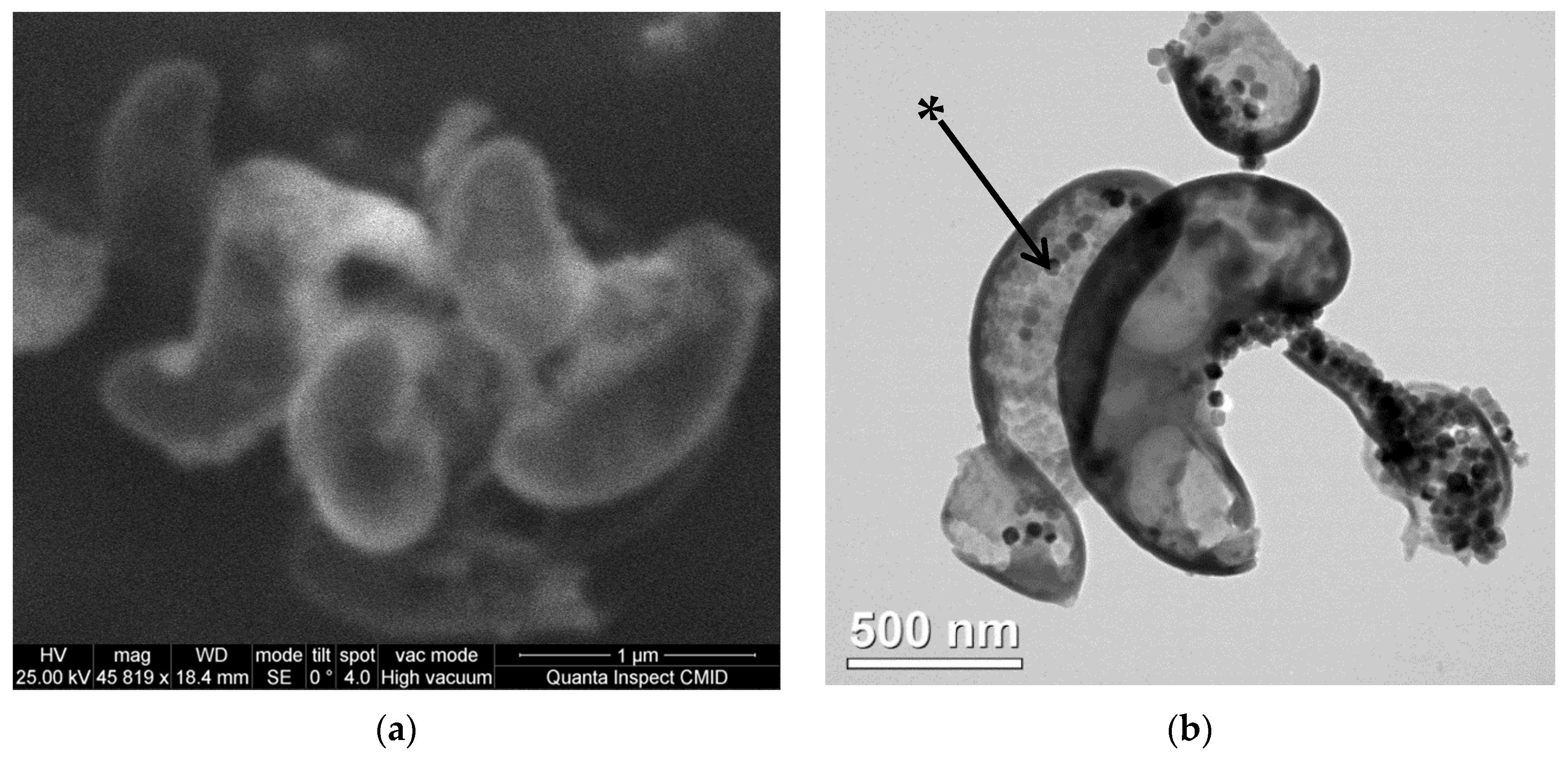
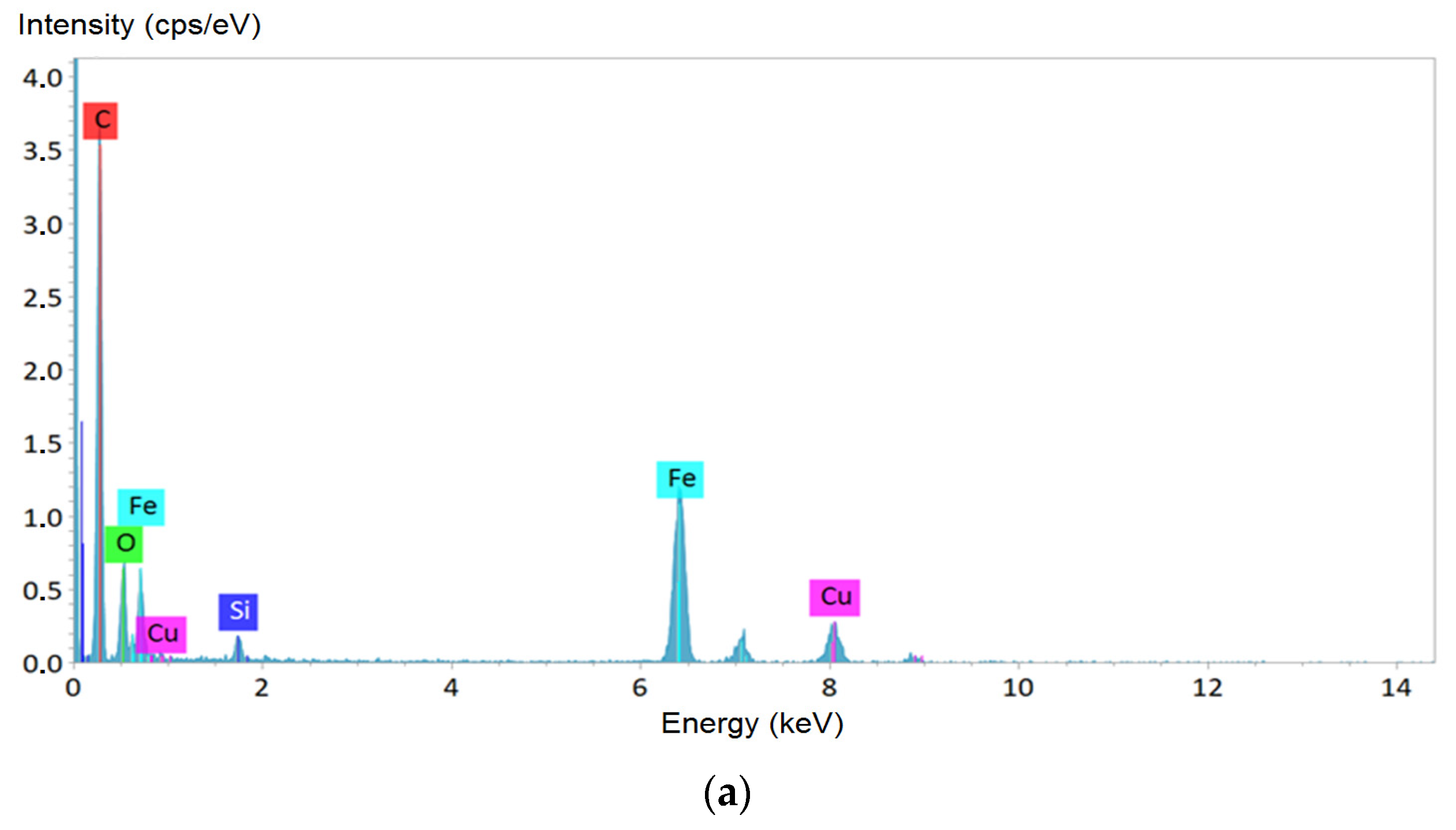
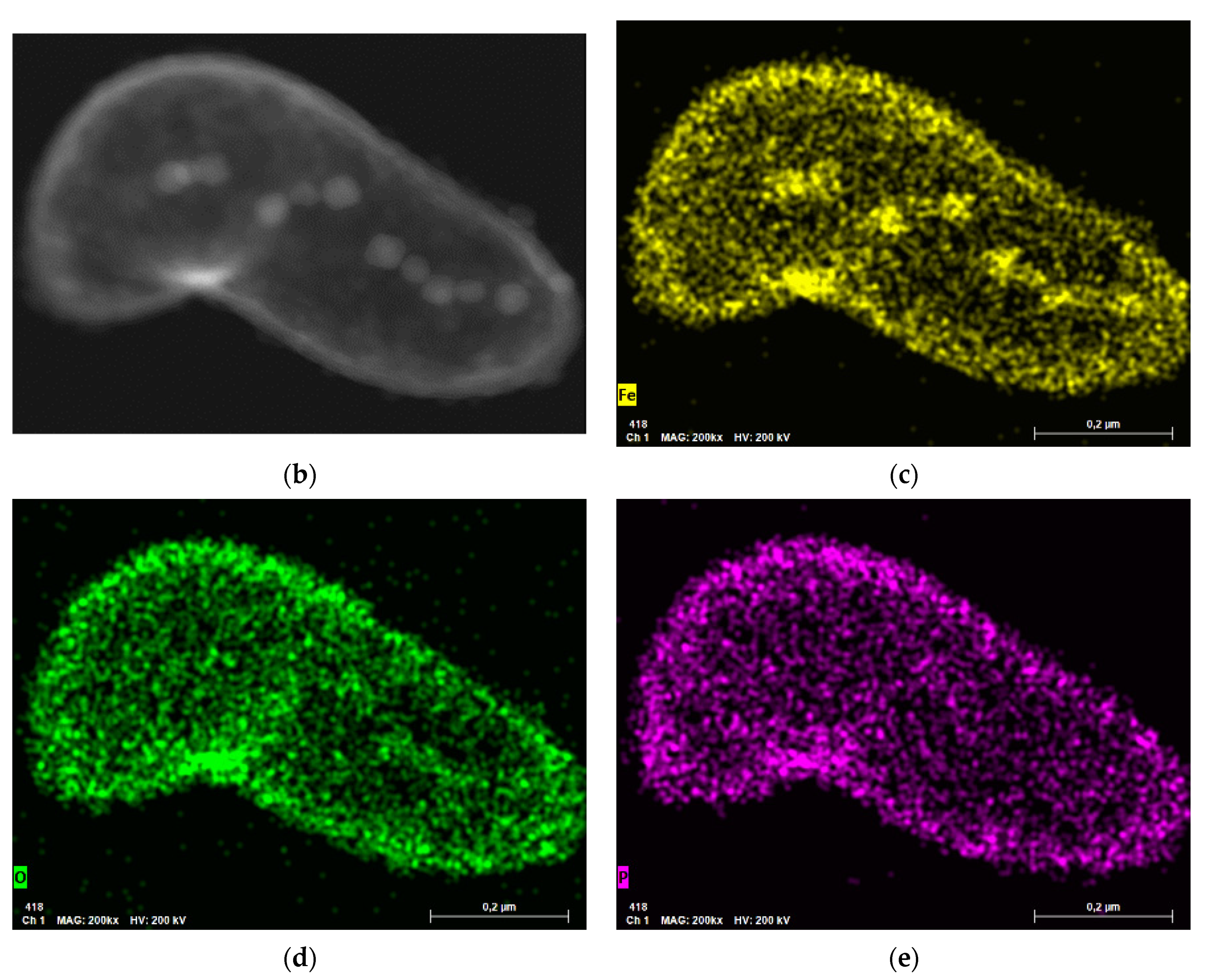
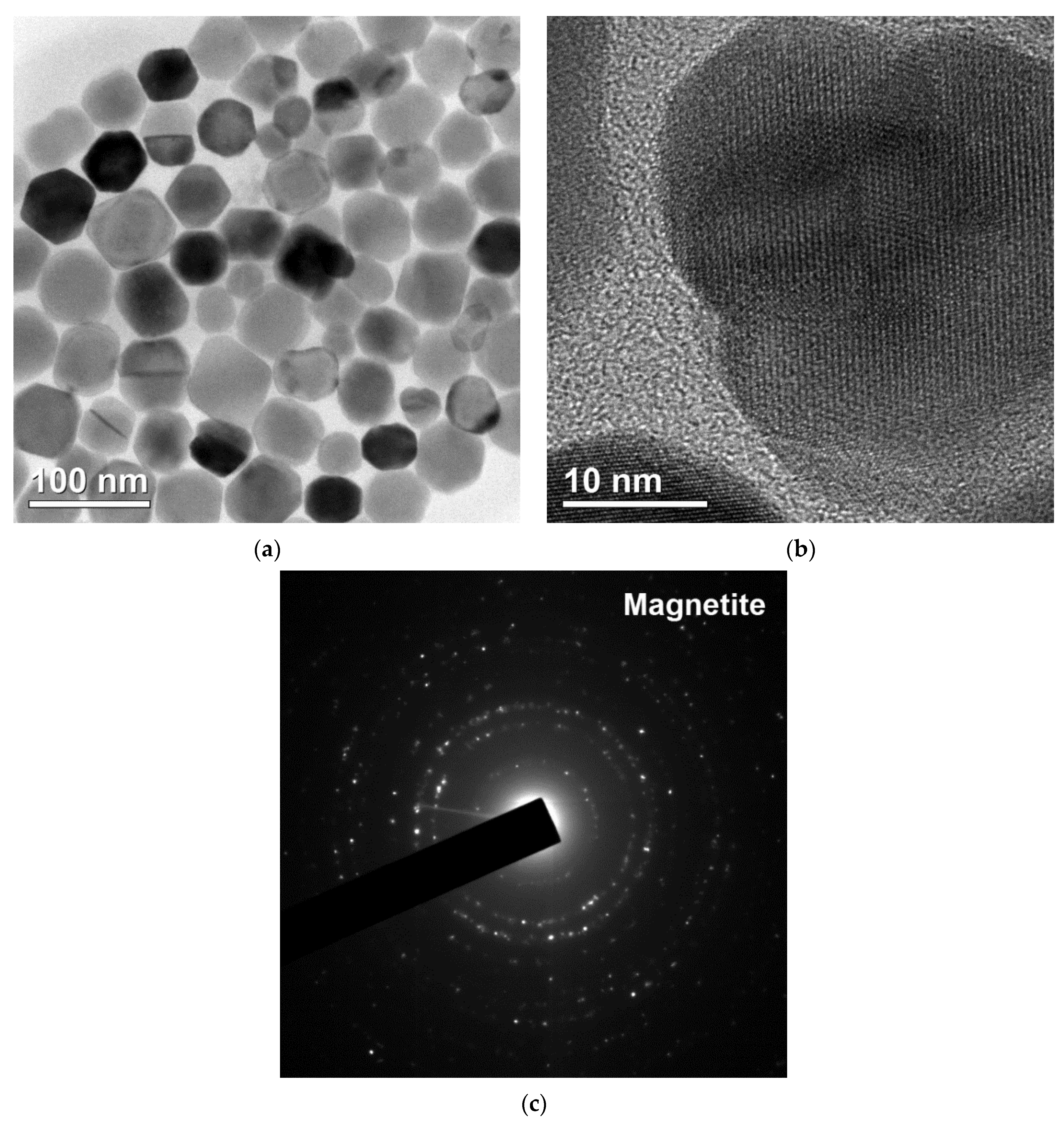
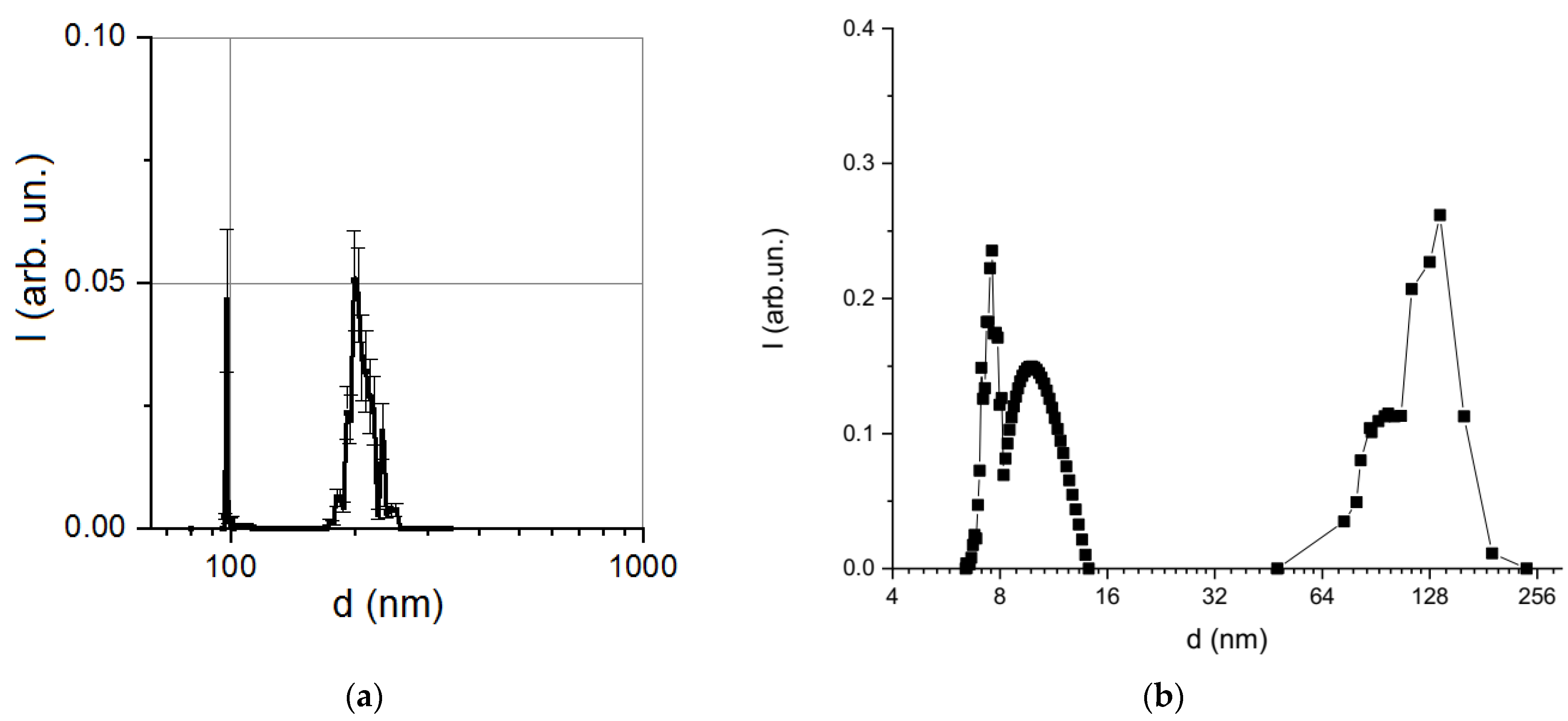
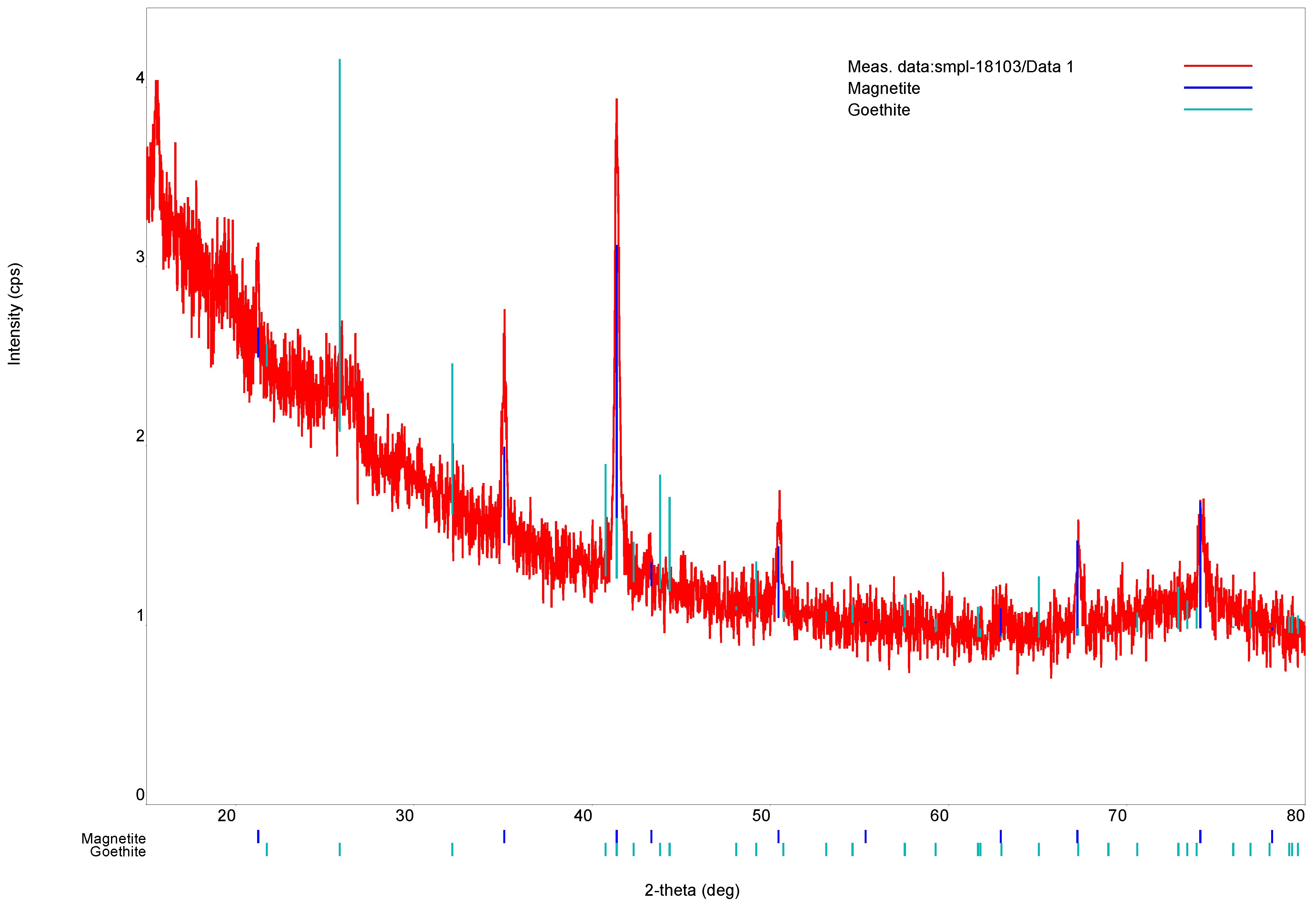
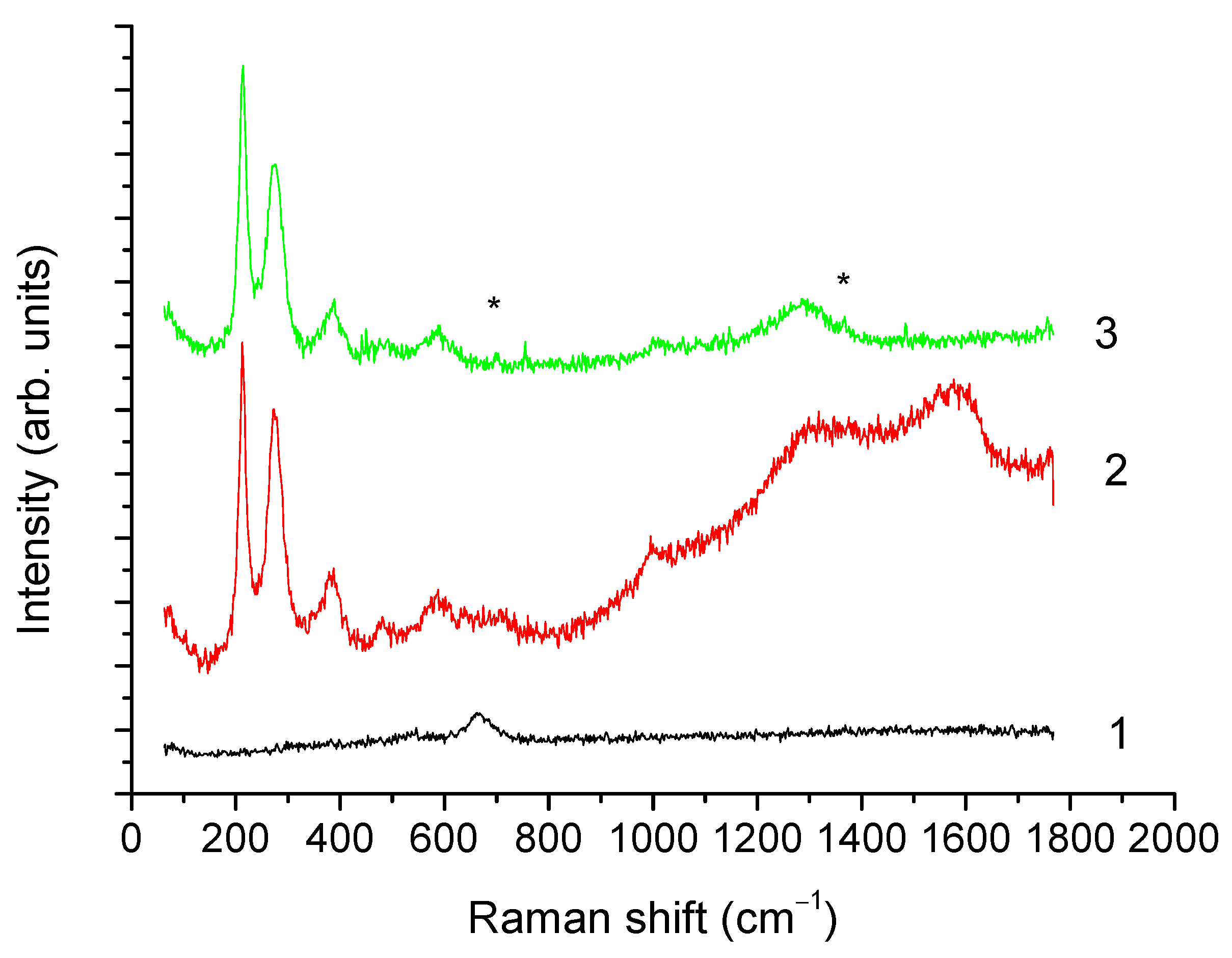
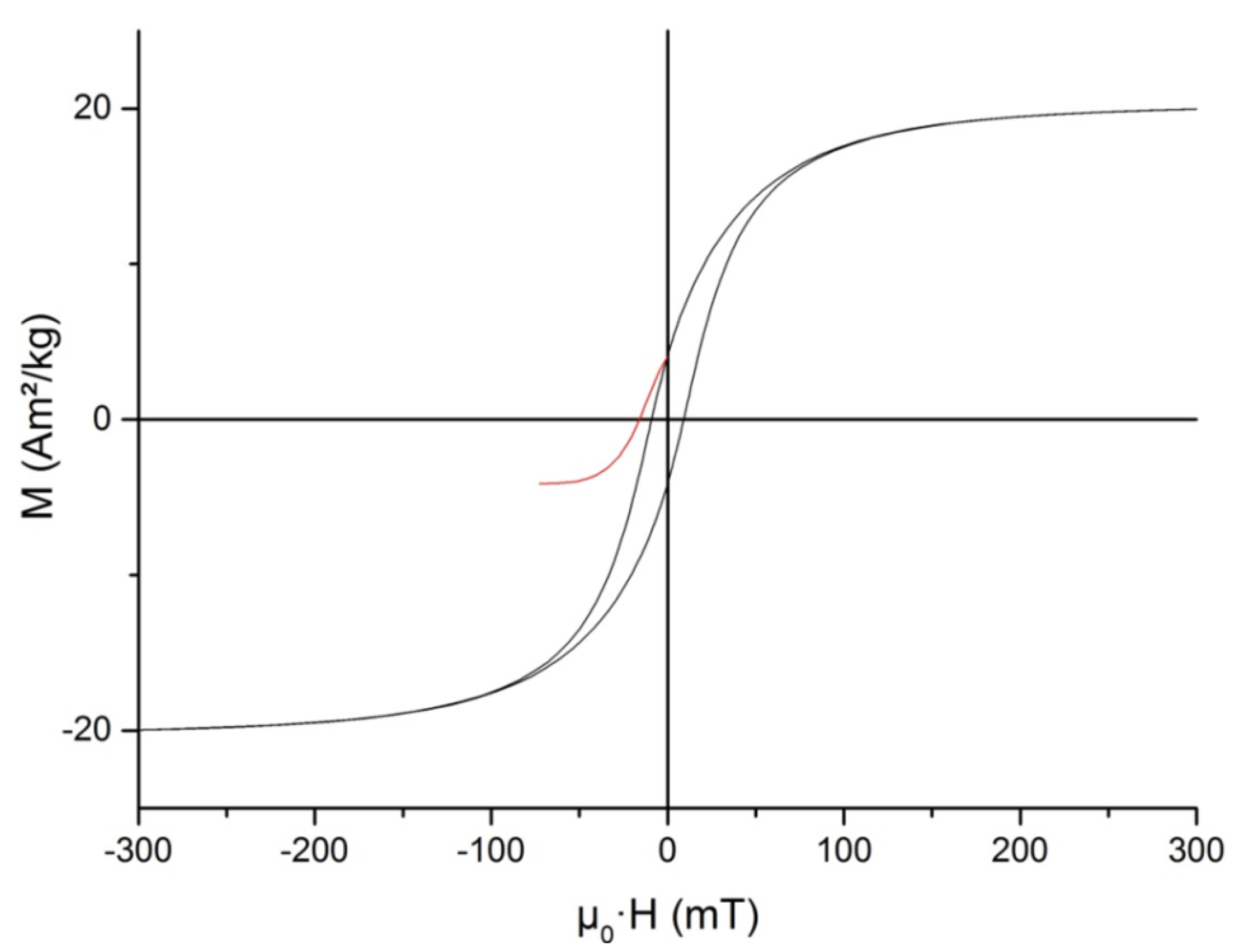
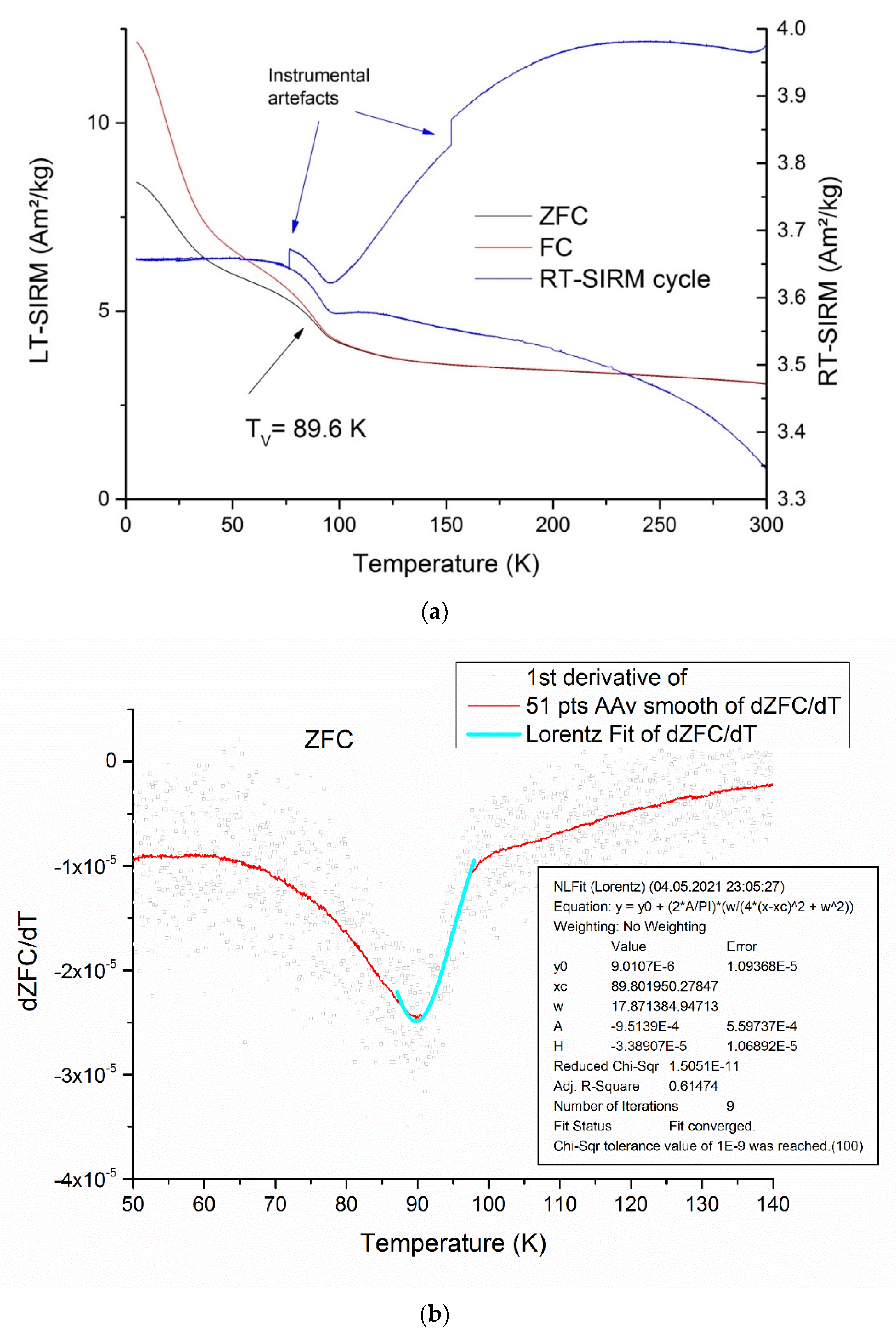

| Species (Strain) of Magnetotactic Bacteria | Mrs/Ms | μ0Hc, mT | μ0Hcr, mT | Hcr/Hc | Refs. |
|---|---|---|---|---|---|
| Magnetospirillum magneticum AMB-1 | 0.31–0.51 | 3.7–24.7 | – | – | [55] |
| 0.46 | 22.5 | 31.9 | 1.42 | [18] | |
| 0.46 | 32.0 | 38.0 | 1.19 | [56] | |
| – | 14.4 | 25.8 | 1.79 | [34] | |
| Magnetospirillum gryphiswaldense MSR-1 | 0.38 | 5.9 | 10.8 | 1.82 | [27] |
| 0.44 | 16.3 | 20.3 | 1.25 | [24] | |
| 0.40 | 15.7 | – | – | [28] | |
| 0.45 | 16.8 | – | – | [57] | |
| 0.37 | 9.6 | 15.2 | 1.58 | [26] | |
| 0.45 | 22.0 | – | – | [58] | |
| Magnetospirillum caucaseum SO-1 | 0.20 | 9.1 | 16.0 | 1.76 | This work |
Publisher’s Note: MDPI stays neutral with regard to jurisdictional claims in published maps and institutional affiliations. |
© 2021 by the authors. Licensee MDPI, Basel, Switzerland. This article is an open access article distributed under the terms and conditions of the Creative Commons Attribution (CC BY) license (https://creativecommons.org/licenses/by/4.0/).
Share and Cite
Gareev, K.G.; Grouzdev, D.S.; Kharitonskii, P.V.; Kirilenko, D.A.; Kosterov, A.; Koziaeva, V.V.; Levitskii, V.S.; Multhoff, G.; Nepomnyashchaya, E.K.; Nikitin, A.V.; et al. Magnetic Properties of Bacterial Magnetosomes Produced by Magnetospirillum caucaseum SO-1. Microorganisms 2021, 9, 1854. https://doi.org/10.3390/microorganisms9091854
Gareev KG, Grouzdev DS, Kharitonskii PV, Kirilenko DA, Kosterov A, Koziaeva VV, Levitskii VS, Multhoff G, Nepomnyashchaya EK, Nikitin AV, et al. Magnetic Properties of Bacterial Magnetosomes Produced by Magnetospirillum caucaseum SO-1. Microorganisms. 2021; 9(9):1854. https://doi.org/10.3390/microorganisms9091854
Chicago/Turabian StyleGareev, Kamil G., Denis S. Grouzdev, Peter V. Kharitonskii, Demid A. Kirilenko, Andrei Kosterov, Veronika V. Koziaeva, Vladimir S. Levitskii, Gabriele Multhoff, Elina K. Nepomnyashchaya, Andrey V. Nikitin, and et al. 2021. "Magnetic Properties of Bacterial Magnetosomes Produced by Magnetospirillum caucaseum SO-1" Microorganisms 9, no. 9: 1854. https://doi.org/10.3390/microorganisms9091854
APA StyleGareev, K. G., Grouzdev, D. S., Kharitonskii, P. V., Kirilenko, D. A., Kosterov, A., Koziaeva, V. V., Levitskii, V. S., Multhoff, G., Nepomnyashchaya, E. K., Nikitin, A. V., Nikitina, A., Sergienko, E. S., Sukharzhevskii, S. M., Terukov, E. I., Trushlyakova, V. V., & Shevtsov, M. (2021). Magnetic Properties of Bacterial Magnetosomes Produced by Magnetospirillum caucaseum SO-1. Microorganisms, 9(9), 1854. https://doi.org/10.3390/microorganisms9091854









